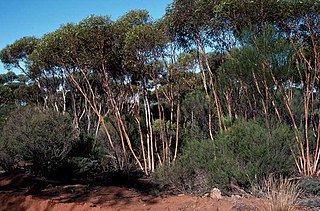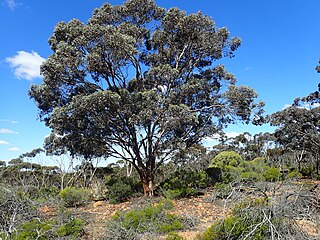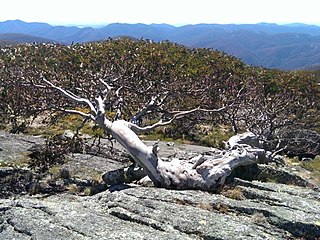
Eucalyptus macrocarpa, commonly known as mottlecah, is a species of mallee that is endemic to the south-west of Western Australia. It has smooth bark, usually sessile, heart-shaped adult leaves arranged in opposite pairs, large red flowers and broad conical fruit.

Eucalyptus wandoo, commonly known as wandoo, dooto, warrnt or wornt, is a small to medium-sized tree that is endemic to the southwest of Western Australia. It has smooth bark, lance-shaped adult leaves, flower buds in groups of nine to seventeen, white flowers and conical to cylindrical fruit. It is one of a number of similar Eucalyptus species known as wandoo.

Eucalyptus capillosa, commonly known as wheatbelt wandoo, or mallee wandoo, is a species of tree or mallee that is endemic to Western Australia. It has smooth, grey bark, lance-shaped to elliptic adult leaves, spindle-shaped flower buds in groups of nine to thirteen, white flowers and barrel-shaped to cylindrical fruit.

Eucalyptus effusa, commonly known as rough-barked gimlet, is a species of mallee or small tree that is endemic to Western Australia. It has thin, rough bark on the base of the trunk, smooth bark above, linear to narrow lance-shaped adult leaves, flower buds arranged in groups of seven, white flowers and cup-shaped to conical fruit.
Eucalyptus exigua is a species of mallee that is endemic to Western Australia. It has smooth, whitish bark, linear to narrow lance-shaped adult leaves, flower buds in groups of between seven and eleven, white flowers and short barrel-shaped to conical fruit.

Eucalyptus fraseri, commonly known as Balladonia gum, is a species of tree or mallet that is endemic to Western Australia. It has smooth white to greyish bark, lance-shaped or curved adult leaves, flower buds in groups of seven or nine, white flowers and cup-shaped, conical or hemispherical fruit.

Eucalyptus gittinsii, commonly known as northern sandplain mallee, is a species of mallee that is endemic to Western Australia. It has smooth greyish bark, sometimes with rough flaky bark near the base, lance-shaped to curved adult leaves, flower buds in groups of three, whitish flowers and cylindrical to barrel-shaped fruit.
Eucalyptus mimica is a species of mallet that is endemic to a small area of Western Australia. It has smooth, shiny bark, linear to narrow elliptical leaves held erect, flower buds in groups of three and conical fruit with ribbed sides.

Eucalyptus phaenophylla, also known as common southern mallee, is a species of mallee that is endemic to Western Australia. It has smooth bark, linear to narrow lance-shaped or narrow elliptical adult leaves, flower buds in groups of up to thirteen, pale lemon-coloured flowers and barrel-shaped, cylindrical or conical fruit.
Eucalyptus subangusta is a species of tree, mallee or mallet that is endemic to the southwest of Western Australia. It has smooth bark, narrow lance-shaped leaves, flower buds in groups of up to nineteen, white flowers and cup-shaped to barrel-shaped fruit.
Eucalyptus tenuis is a species of slender mallet that is endemic to the southwest of Western Australia. It has smooth bark, lance-shaped adult leaves, flower buds in groups of three, creamy white flowers and conical, cup-shaped or bell-shaped fruit.
Eucalyptus thamnoides is a species of mallee that is endemic to south western Western Australia. It has smooth bark, lance-shaped adult leaves, flower buds in groups of seven, cream-coloured to pale yellow flowers and cup-shaped, conical or bell-shaped fruit.

Eucalyptus celastroides, commonly known by the Noongar name of mirret, is a species of eucalypt that is endemic to the south-west of Western Australia. It is a mallee, rarely a tree, and has rough bark on about half of the lower half of its tunk, smooth above, narrow lance-shaped adult leaves, flower buds in groups of seven or nine, white flowers and urn-shaped fruit.

Eucalyptus cerasiformis, commonly known as the cherry-fruited mallee, is a mallee that is endemic to a small area of Western Australia. It has smooth, pale grey, sometimes powdery bark, lance-shaped adult leaves, flower buds in groups of seven, pale yellow or whitish flowers and cylindrical or bell-shaped fruit.

Eucalyptus crucis is a species of mallee that is endemic to Western Australia. There are three subspecies, commonly known as silver mallee or Southern Cross mallee,, narrow-leaved silver mallee, and Paynes Find mallee,. It has rough bark that is shed in curling flakes, more or less round, glaucous juvenile leaves, egg-shaped intermediate leaves and lance-shaped adult leaves. The type of bark and the proportion of juvenile, intermediate and adult leaves in the crown of mature plants varies with subspecies. The flower buds are arranged in groups of seven in leaf axils, the flowers are whitish to pale yellow and the fruit is a conical to hemispherical capsule.

Eucalyptus densa is a species of mallee or mallet that is endemic to Western Australia. It has smooth greyish bark that is shed in curly strips, linear to narrow lance-shaped adult leaves, long, spindle-shaped flower buds in groups of seven or nine, pale yellow or lemon-coloured flowers and conical, cylindrical or barrel-shaped fruit.
Eucalyptus lockyeri, commonly known as Lockyer's box, is a species of small tree endemic to a small area in Queensland. It has rough bark near the base of the trunk, smooth bark above, lance-shaped adult leaves, flower buds in groups of seven, white flowers and hemispherical fruit.

Eucalyptus pauciflora subsp. debeuzevillei, commonly known as Jounama snow gum, is a mallee or small tree that is native to a few mountain peaks in south-eastern Australia. It has smooth, shiny bark, glossy green lance-shaped to egg-shaped leaves, flower buds in groups of between nine and fifteen, white flowers and hemispherical or conical fruit. It differs from other subspecies of E. pauciflora in having angular flower buds.

Eucalyptus pauciflora subsp. niphophila, commonly known as snow gum, is a small tree or large shrub that is native to a few mountain peaks in eastern Australia. It has smooth bark, glossy green, lance-shaped to egg-shaped or elliptical leaves, flower buds in groups of between nine and fifteen, white flowers and cup-shaped, hemispherical or conical fruit. It differs from other subspecies of E. pauciflora in having more delicate, pedicellate flower buds and smaller leaves.

Eucalyptus pauciflora subsp. pauciflora, commonly known as snow gum, cabbage gum or white sally is a tree or mallee that is endemic to eastern Australia. It has smooth bark, glossy green, lance-shaped, curved or elliptical leaves, flower buds in groups of between nine and fifteen, white flowers and cup-shaped, hemispherical or conical fruit.

















